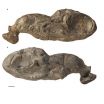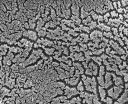(Press-News.org) The skull of a newly discovered 325-million-year-old shark-like species suggests that early cartilaginous and bony fishes have more to tell us about the early evolution of jawed vertebrates—including humans—than do modern sharks, as was previously thought. The new study, led by scientists at the American Museum of Natural History, shows that living sharks are actually quite advanced in evolutionary terms, despite having retained their basic "sharkiness" over millions of years. The research is published today in the journal Nature.
"Sharks are traditionally thought to be one of the most primitive surviving jawed vertebrates. And most textbooks in schools today say that the internal jaw structures of modern sharks should look very similar to those in primitive shark-like fishes," said Alan Pradel, a postdoctoral researcher at the Museum and the lead author of the study. "But we've found that's not the case. The modern shark condition is very specialized, very derived, and not primitive."
The new study is based on an extremely well-preserved shark fossil collected by Ohio University professors Royal Mapes and Gene Mapes in Arkansas, where an ocean basin once was home to a diverse marine ecosystem. The fossilized skull of the new species, named Ozarcus mapesae, along with similar specimens from the same location, were part of a recent donation of 540,000 fossils from Ohio University to the Museum.
The heads of all fishes—sharks included—are segmented into the jaws and a series of arches that support the jaw and the gills. These arches are thought to have given rise to jaws early in the tree of life.
Because shark skeletons are made of cartilage, not bone, their fossils are very fragile and are usually found in flattened fragments, making it impossible to study the shape of these internal structures. But the Ozarcus mapesae specimen was preserved in a nearly three-dimensional state, giving researchers a rare glimpse at the organization of the arches in a prehistoric animal.
"This beautiful fossil offers one of the first complete looks at all of the gill arches and associated structures in an early shark. There are other shark fossils like this in existence, but this is the oldest one in which you can see everything," said John Maisey, a curator in the Museum's Division of Paleontology and one of the authors on the study. "There's enough depth in this fossil to allow us to scan it and digitally dissect out the cartilage skeleton."
Working with scientists at the European Synchrotron, the ESRF, Pradel imaged the specimen with high-resolution x-rays to get a detailed view of each individual arch shape and organization. "We discovered that the arrangement of the arches is not like anything you'd see in a modern shark or shark-like fish," said Pradel. "Instead, the arrangement is fundamentally the same as bony fishes."
The authors say it's not unexpected that sharks—which have existed for about 420 million years—would undergo evolution of these structures. But the new work, especially when considered alongside other recent developments about early jawed vertebrates, has significant implications for the future of evolutionary studies of this group. "Bony fishes might have more to tell us about our first jawed ancestors than do living sharks," Maisey said.
INFORMATION:
Other authors on the paper include Paul Tafforeau, a beamline scientist at the European Synchrotron in Grenoble, France, and Jon Mallatt, a researcher from Washington State University.
Funding for this study was provided in part by the Herbert & Evelyn Axelrod Research Chair in Paleoichthyology at the Museum.
Ancient shark fossil reveals new insights into jaw evolution
Skull structures of 325-million-year-old shark fossil show that living sharks are evolutionarily advanced
2014-04-16
ELSE PRESS RELEASES FROM THIS DATE:
Scientists re-define what's healthy in newest analysis for Human Microbiome Project
2014-04-16
ANN ARBOR, Mich. – As scientists catalog the trillions of bacteria found in every nook and cranny of the human body, a new look by the University of Michigan shows wide variation in the types of bacteria found in healthy people.
Based on their findings in today's
Nature, there is no single healthy microbiome. Rather each person harbors a unique and varied collection of bacteria that's the result of life history as well their interactions with the environment, diet and medication use.
"Understanding the diversity of community types and the mechanisms that result ...
Sperm meets egg: Protein essential for fertilization discovered
2014-04-16
Researchers at the Wellcome Trust Sanger Institute have discovered interacting proteins on the surface of the sperm and the egg essential to begin mammalian life. These proteins, which allow the sperm and egg to recognize one another, offer new paths towards improved fertility treatments and the development of new contraceptives.
Fertilisation occurs when an egg and a sperm recognise each other and fuse together to form an embryo. The Izumo protein displayed on the sperm that recognises the egg was identified in 2005 by Japanese researchers who named it Izumo, after a ...
Hide and seek: Revealing camouflaged bacteria
2014-04-16
A research team at the Biozentrum of the University of Basel has discovered an protein family that plays a central role in the fight against the bacterial pathogen Salmonella within the cells. The so called interferon-induced GTPases reveal and eliminate the bacterium's camouflage in the cell, enabling the cell to recognize the pathogen and to render it innocuous. The findings are published in the current issue of the science magazine Nature.
Bacteria have developed countless strategies to hide themselves in order to evade attack by the immune system. In the body, Salmonella ...
Why your nose can be a pathfinder
2014-04-16
Waves in your brain make smells stick to your memories and inner maps.
When I was a child I used to sit in my grandfather's workshop, playing with wood shavings. Freshly shaven wood has a distinct smell of childhood happiness, and whenever I get a whiff of that scent my brain immediately conjures up images of my grandfather at his working bench, the heat from the fireplace and the dog next to it.
Researchers at the Kavli Institute for Systems Neuroscience have recently discovered the process behind this phenomenon. The brain, it turns out, connects smells to memories ...
Rice U. study: Performance measures for CEOs vary greatly
2014-04-16
HOUSTON – (April 16, 2014) – As companies file their annual proxy statements with the U.S. Securities and Exchange Commission (SEC) this spring, a new study by Rice University and Cornell University shows just how S&P 500 companies have tied CEO compensation to performance. The study found large variations in the choice of performance measures, and the researchers said that companies tend to choose measures that are informative of CEO actions.
"On average, firms rely mostly on accounting-based performance measures, among which they put heavier weights on income measures, ...
Progress in the fight against quantum dissipation
2014-04-16
Scientists at Yale have confirmed a 50-year-old, previously untested theoretical prediction in physics and improved the energy storage time of a quantum switch by several orders of magnitude. They report their results in the April 17 issue of the journal Nature.
High-quality quantum switches are essential for the development of quantum computers and the quantum internet — innovations that would offer vastly greater information processing power and speed than classical (digital) computers, as well as more secure information transmission.
"Fighting dissipation is one ...
Why interest is crucial to your success
2014-04-16
DURHAM, N.C. -- Maintaining an interest in the goals you pursue can improve your work and reduce burnout, according to research from Duke University.
"Our research shows that interest is important in the process of pursuing goals. It allows us to perform at high levels without wearing out," said Paul O'Keefe, who conducted the studies as a doctoral student in Duke University's Department of Psychology & Neuroscience, along with associate professor Lisa Linnenbrink-Garcia. "This suggests that interest matters more than we suspected."
The studies, which appear online ...
Dartmouth-led study shows air temperature influenced African glacial movements
2014-04-16
Changes in air temperature, not precipitation, drove the expansion and contraction of glaciers in Africa's Rwenzori Mountains at the height of the last ice age, according to a Dartmouth-led study funded by the National Geographic Society and the National Science Foundation.
The results – along with a recent Dartmouth-led study that found air temperature also likely influenced the fluctuating size of South America's Quelccaya Ice Cap over the past millennium -- support many scientists' suspicions that today's tropical glaciers are rapidly shrinking primarily because of ...
Scientists unlock secrets of protein produced by disease-causing fungus
2014-04-16
SAN ANTONIO, Texas (April 16, 2014) — A team that includes scientists from the School of Medicine at The University of Texas Health Science Center at San Antonio, Johns Hopkins University and St. Mary's University reported the structure of a protein that helps a common fungus to infect the body.
The fungal pathogen Candida albicans causes yeast infections, diaper rashes and oral thrush, and is the most common fungal pathogen to infect humans. It can also cause a life-threatening infection of the blood called disseminated candidiasis.
"In this study, we determined the ...
Vanderbilt researchers discover how intestinal cells build nutrient-absorbing surface
2014-04-16
The "brush border" – a densely packed array of finger-like projections called microvilli – covers the surfaces of the cells that line our intestines.
Vanderbilt University researchers have now discovered how intestinal cells build this specialized structure, which is critical for absorbing nutrients and defending against pathogens. The findings, published April 10 in the journal Cell, reveal a role for adhesion molecules in brush border assembly and increase our understanding of intestinal pathologies associated with inherited and infectious diseases.
Pathogens that destroy ...
LAST 30 PRESS RELEASES:
Heart-brain connection: international study reveals the role of the vagus nerve in keeping the heart young
Researchers identify Rb1 as a predictive biomarker for a new therapeutic strategy in some breast cancers
Survey reveals ethical gaps slowing AI adoption in pediatric surgery
Stimulant ADHD medications work differently than thought
AI overestimates how smart people are, according to HSE economists
HSE researchers create genome-wide map of quadruplexes
Scientists boost cell "powerhouses" to burn more calories
Automatic label checking: The missing step in making reliable medical AI
Low daily alcohol intake linked to 50% heightened mouth cancer risk in India
American Meteorological Society announces Rick Spinrad as 2026 President-Elect
Biomass-based carbon capture spotlighted in newly released global climate webinar recording
Illuminating invisible nano pollutants: advanced bioimaging tracks the full journey of emerging nanoscale contaminants in living systems
How does age affect recovery from spinal cord injury?
Novel AI tool offers prognosis for patients with head and neck cancer
Fathers’ microplastic exposure tied to their children’s metabolic problems
Research validates laboratory model for studying high-grade serous ovarian cancer
SIR 2026 delivers transformative breakthroughs in minimally invasive medicine to improve patient care
Stem Cell Reports most downloaded papers of 2025 highlight the breadth and impact of stem cell research
Oxford-led study estimates NHS spends around 3% of its primary and secondary care budget on the health impacts of heat and cold in England
A researcher’s long quest leads to a smart composite breakthrough
Urban wild bees act as “microbial sensors” of city health.
New study finds where you live affects recovery after a hip fracture
Forecasting the impact of fully automated vehicle adoption on US road traffic injuries
Alcohol-related hospitalizations from 2016 to 2022
Semaglutide and hospitalizations in patients with obesity and established cardiovascular disease
Researchers ‘listen in’ to embryo-mother interactions during implantation using a culture system replicating the womb lining
How changing your diet could help save the world
How to make AI truly scalable and reliable for real-time traffic assignment?
Beyond fragmented markets: A new framework for efficient and stable ride-pooling
Can shape priors make road perception more reliable for autonomous driving?
[Press-News.org] Ancient shark fossil reveals new insights into jaw evolutionSkull structures of 325-million-year-old shark fossil show that living sharks are evolutionarily advanced





